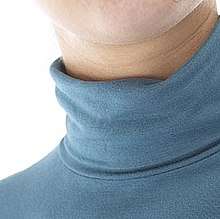Polo neck
A polo neck, roll-neck[1] (UK), turtleneck (US, Canada), or skivvy (Australia, New Zealand, US) is a garment—usually a sweater—with a close-fitting, round, and high part similar to a collar that folds over and covers the neck. It can also refer to the type of neckline, the style of collar itself, or be used as an adjective ("polo necked").

A simpler variant of the standard polo neck is the mock polo neck (or mock turtleneck), that resembles the polo neck with the soft fold at its top and the way it stands up around the neck, but both ends of the tube forming the collar are sewn to the neckline. This is mainly used to achieve the appearance of a polo neck where the fabric would fray, roll, or otherwise behave badly unless sewn. The mock polo neck clings to the neck smoothly, is easy to manufacture, and works well with a zip closure.
History
Europe
Turtle neck-like garments have been worn for hundreds of years, dating at least to the 15th century. They were originally designed to protect the necks of knights wearing chainmail. Royalty adopted high-neck fashion, with the height and volume of the neck ruffly indicating status.[2]
From the late 19th century on, polo necks were commonly worn by menial workers, athletes, sailors and naval officers.[3] Since the middle of the 20th century black polo necks have been closely associated with radical academics, philosophers, artists and intellectuals.[4][5] Also in the early 20th century, the polo neck shirt became a fashionable option for women with the rise of the Gibson Girl.[6] The polo neck jumper became an iconic symbol of the French philosopher Michel Foucault.[7] Polo necks also became a big fashion for young wealthy men after they were worn by European film stars Marcello Mastroianni and Yves Montand.[8]
Greta Garbo often wore polo necks and trousers privately, as later Audrey Hepburn would do in official photographs.
Vladimir Putin[9] of Russia and Andreas Papandreou[10] of Greece are two examples of European leaders fond of wearing polo necks.
United States
Their adoption by Noël Coward in the 1920s turned polo necks into a brief middle-class fashion trend, and feminists made them into a unisex item. Absorbed into mainstream American fashion by the mid 20th century, the polo neck came to be viewed as an anti-tie, a smart form of dress for those who rejected formal wear. Senator Ted Kennedy, pianist/conductor Vladimir Ashkenazy, conductor Seiji Ozawa, philosopher Michel Foucault, shipping tycoon Stavros Niarchos, singer Barry Manilow, scientist Carl Sagan, Oracle Corporation co-founder Larry Ellison, Theranos founder Elizabeth Holmes, and Apple Inc. co-founder Steve Jobs were among those often seen in polo necks.
Over time it became a fad among teenage girls, especially in a lightweight form that emphasised their figures. It was not long before Hollywood was also exploiting this image as part of the sweater girl look.
By the late 1950s the "tight turtleneck" had been adopted as part of the preppy style among students, a style emphasising neatness, tidiness and grooming. This would become an important aspect of the polo neck's image in the United States. The look would filter through to Britain and the rest of Europe in a watered-down version.
Very elegant polo necks of silk or nylon knit, especially made with French cuffs for formal dress affairs, have also seen success in American fashion.[11] They have become iconic fashion choices for Steve Jobs and Elizabeth Holmes.[12]
As an alternative to the necktie
.jpg)
Historically, polo necks were used as substitutes for a shirt-and-tie.[14] This was sometimes frowned upon in upscale restaurants and at weddings.
John Berendt wrote in Esquire[14]
the turtleneck was the boldest of all the affronts to the status quo. It was the picture of masculine poise and arrogance, redolent of athletes, sportsmen, even U-boat commanders. The simplicity of its design made neckties seem fussy and superfluous by comparison
turtlenecks are the most comfortable garment you can wear. They move with the body, and they're flattering too, because they accentuate the face and elongate the figure. They make life so easy: you can wear a turtleneck to work and then afterwards throw on a jacket, and it becomes very dressy. You can go anywhere you like.
See also
References
- Chilvers, Simon (2011-08-23). "Man-trend: Roll-necks | Fashion | guardian.co.uk". Guardian. Retrieved 2013-03-14.
- Sourcing, 01 10 2017 | Fashion Fabric (2017-01-10). "Fashion Archives: A Look at the History of the Turtleneck". StartUp FASHION. Retrieved 2020-04-02.
- "The Radical History & Psychology Of Turtlenecks". The Good Trade. Retrieved 2020-04-02.
- Mary Ann Frese Witt, The Humanities: The humanities and the modern world, 2000, pages 463-464
- Deirdre Bair, Simone de Beauvoir:a biography, 1990, page 360
- "The Radical History & Psychology Of Turtlenecks". The Good Trade. Retrieved 2020-04-02.
- Eribon, Didier (1992) [1989]. Michel Foucault. Betsy Wing (translator). Cambridge, MAS.: Harvard University Press. p. 311. ISBN 978-0-571-14474-7.
- Guido Vergani, Dizionario della moda, 2009, page 348 (in Italian)
- Zbigniew Brzezinski, Putin's choice, 2008,
- Theodore C. Kariotis, The Greek socialist experiment: Papandreou's Greece 1981–1989, 1992
- American Costume, 1915-1970: A Source Book for the Stage Costumer. Books.google.gr. 1989-08-22. Retrieved 2013-03-14.
- Warde-Aldam, Digby. "How the black turtleneck came to represent creative genius". CNN. Retrieved 2020-04-02.
- Olivarez-Giles, Nathan (October 11, 2011). "Steve Jobs' black turtleneck reportedly explained in biography". Los Angeles Times. Technology (blog). Retrieved June 7, 2014.
- Hoffmann, Frank W.; William G. Bailey (1994). Fashion & Merchandising Fads. Haworth Popular Culture. Binghamton, N.Y.: The Haworth Press. pp. 267–268. ISBN 9781560243762. OCLC 27225478.
External links
| Wikimedia Commons has media related to Turtlenecks. |